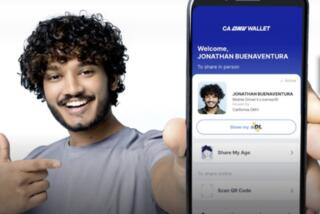More California motorists using phones while driving, study finds
- Share via
California drivers sure have had their hands full this year.
One in 10 drivers had their attention diverted by texting, calling or fumbling with their phones — a nearly 40% increase from last year, according to an annual observational study conducted on behalf of the state’s Office of Traffic Safety.
But the true tally of behind-the-wheel phone users probably tops 20%, or 1 in 5 drivers, said Chris Cochran, a spokesman for the agency. The discrepancy is owed to the limited view of researchers, who performed the study by peering into passing cars. Not all phone use is easily visible, Cochran said.
The growth in phone usage — the first such increase in several years — underscores the growing boldness of motorists and the priority of mobile communication, with drivers emailing, texting and, yes, making calls while traveling on the state’s traffic-clogged roadways.
“There’s a certain amount of tech addiction,” Cochran said. “People are addicted to the ping of a text coming in.”
The increase in phone use did not surprise Dani Weisfeld, 18, who said that social media is such a big part of people’s daily lives that it’s difficult to put down the phone.
“It’s not just teenagers, either,” Weisfeld said. “My dad does it sometimes.”
Another young driver, Brandon Louey, 21, said he had never seen anyone pulled over for texting or using a phone. He thinks a lot of people text or make calls because they don’t believe they’ll get caught by police or get in an accident.
Although most drivers adhere to the state’s ban on texting and hand-held phone use, officials cautioned that those who do use phones illegally while driving pose a threat to motorists and pedestrians alike.
In 2013, about 3,154 people were killed in accidents because a driver was distracted by technology, according to the U.S. Department of Transportation.
Though California doesn’t collect consistent data, it’s estimated that between 300 and 400 people die each year in accidents caused by a driver’s attention being compromised by a phone, Cochran said.
Amid the well-publicized dangers of phone usage, many drivers carve out specific times on their commute to glance at the phone. Anne Carson, 27, admitted that she occasionally texts while on the road but says she does so only at red lights.
The tendency to text in places that feel safer might explain why suburbs have the highest rate of distracted driving. Long red lights and quiet roads with low speed limits were two places some drivers said they would be more likely to risk a text.
Phones aren’t the only gadget that can intrude on a driver’s awareness.
In-dash entertainment systems that allow for navigation, hands-free calls and voice-to-text messaging can be just as distracting. Car manufacturers are increasingly outfitting vehicles with such technologies, another potential drain on attention.
Still, state and federal officials agree that newer technologies may prove the best solution to ending phone-induced distractions on the roadway.
Cochran expressed his desire for a technology that would prevent a driver from texting while also allowing passengers to use their phones freely.
To Carson, texting doesn’t seem to be the dominant phone activity that causes dangerous situations or slows down traffic on the freeway.
Each day, she sees professionals talking on their phones, while younger people, she said, tend to scroll through Facebook or Instagram feeds from behind the wheel.
One phone function seems to outstrip all the others, she said. It pops onto the screens of drivers from varying age groups: GPS.
“If I use my phone while driving, it’s to use the GPS map,” she said. “Everyone is using that.”
Twitter: @katemshepherd
More to Read
Sign up for Essential California
The most important California stories and recommendations in your inbox every morning.
You may occasionally receive promotional content from the Los Angeles Times.













